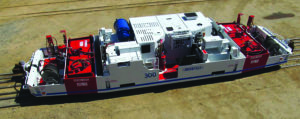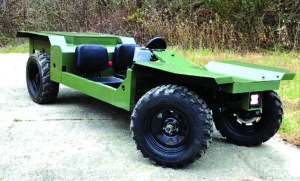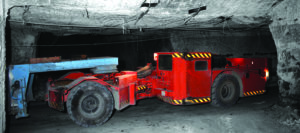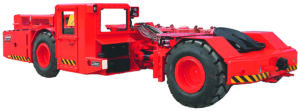
Brookville light-duty locomotives are highly customizable and can be modified with a range of ends. Above, a locomotive is configured as an 8-man maintenance unit with a crane. (Photo: Brookville)
The top-selling solutions empower the customer to do more work with fewer machines
by jesse morton, technical writer
The top suppliers in the utility equipment space said customer feedback shows that versatile solutions add value. Therefore, they are in high demand. Examples include solutions that are long proven and one that is new.
Customizable Light-duty Locomotives
Brookville Equipment Corp. reported its customizable light-duty locomotives are now a staple in Appalachian underground coal mines due to the significant efficiency gains offered.
“This particular vehicle platform has become a standard in Appalachian coal mining where rail-based vehicles are being used,” said Michael White, director of sales, Brookville. The platform “has been a great win for us.”
It is also a win for the mines, and for the miner, he said. “If a guy transfers from one mine to another, takes a new job, and moves his family, he knows a Brookville locomotive when he sees it,” White said. “He knows how to operate it and how to do maintenance on it,” he said. “It is now a very standardized vehicle across the market.”
The locomotive platform is common, but the long list of ends offered enable it to be built specific to a mine, an operation or an application. “We have multiple ends that we can put on that vehicle,” White said. “It is built into the unit so it is not like a bolt-on application.” It can “carry passengers on one end of the unit and the other can hold acetylene torches, welders, cranes, air compressors or grease gun.”
It can be designed to haul tools or a grinder. “Or shop lights so they can light up an area and do heavy maintenance on another piece of equipment,” White said.
“Also, we have made this same vehicle into a fuel buffalo, a mobile fuel storage vehicle that actually has separate pumps on either end of the car that can pump up to 150 gallons of diesel fuel out of each end,” he said. “So 300 gallons total that it can carry around to different portions of the mine and refill all their pieces of equipment.”
Even the ultra-low-height locomotive can be configured to carry a welder or crane. “Each one of those does have options, but it is the same platform,” White said. “You teach an operator how to move this particular vehicle, and he can jump into another one and run men up to the longwall face or he can get into a different one and go out to the belt line and make some repairs if necessary.”
Both platforms come standard with a “heavy-duty frame, planetary axles, liquid-cooled wet disc brakes, V-Spring suspension,” and a “fire suppression system,” the company said.
Optional features include “Liftwalker or Jackwalker Rerailing System,” Brookville said. The systems raise the locomotive as much as a foot and moves it laterally as much as 8 in., “initiating the walking process,” Brookville said.
Diesel low-height mining locomotives have a “power-shift transmission and transfer case, and an advanced filtration exhaust system” that “meets West Virginia and Pennsylvania state regulations for diesel emissions,” Brookville said.
Battery low-height mining locomotives have a “solid-state IGBT electronic control system,” a “30- to 100-hp motor, easy lift-out battery trays,” and a “LED warning panel,” Brookville said.
When configured as personnel carriers, the locomotive can carry up to 18 passengers. It offers “cushioned bench seating and overhead covers to provide maximum comfort and safety for workers as they move throughout the restrictive space of your mine,” Brookville said.
Optional LED backlit gauge panels “provide vehicle operators with easy assessments and diagnostics checks, even in the darkest locations,” Brookville said. With the optional integrated rearview camera, “operators can more easily gauge their proximity to couplers or obstructions, improving workplace safety while eliminating
the need for additional spotters.”

Diesel low-height locomotives by Brookville, such as the personnel carrier above, have a power-shift transmission and transfer case, and an advanced filtration exhaust system. (Photo: Brookville)
The light-duty locomotive platform first hit the market in the early 1990s. “As we started to embrace going from trolley vehicles and battery to diesel units, this particular platform became very unique,” White said. “We would typically build them for just personnel, and then as the operators started to use them more they started to say, ‘Can I carry some tools with me?’”
Brookville started to offer more ends for the locomotives. “Sometimes we would make it like a little rail runner, as a fireboss, or maybe the superintendent of the mine would need something just to haul him and a couple of guys somewhere,” White said. “So we put short passenger compartment ends on it,” he said. “And folks asked, ‘Well can we throw a crane on it?’”
From a passenger and crane combo, “it just evolved into the fuel buffalo” and beyond, White said. “And so over the past 10 years, this particular vehicle has become a staple of our fleet.”
Recently, the supplier “secured a new customer in West Virginia,” he said.
“The main thing he was looking for was light-duty locomotives, personnel carriers, and maintenance units,” White said. The customer wanted minimal platform changes with each unit having the same engines, and oil filters and transmissions.
“It reduces the parts inventory that the folks are keeping,” White said. “It reduces the number of applications that the guys have to be trained on to do maintenance,” he said. “It really made it a no-brainer for these guys to say that we want a unit that fulfills all of our needs.”
Brookville light-duty low-height locomotives are for shafts with a height of at least 50 in. “So if you go 75 or 80 in., that is fine,” White said. “Typically we offer vehicles that can run in seams of 8- to 9-ft wide, 56 in. or higher,” he said. “Travelling through water, if the mine is a real wet mine, and those kinds of things can be addressed.”
The main constraints on the ends are the rules of the regulators and the equipment available on the market. “Ultimately, we are an integrator,” White said. For example, Brookville does not make the crane. It installs and integrates it.
That typically means Brookville can build a solution for most challenges. “We will make a unit specific for the mine application,” White said. “Whatever it might be, Brookville will make that vehicle.”

The light-duty locomotive platform by BROOKVILLE can be built into a fuel buffalo, such as the one above, that can transport up to 300 gallons of gas to different areas of a mine. (Photo: Brookville)
Lithium Battery for Multiple Applications
Grace Equipment Co. announced a lithium-ion battery for personnel carriers and other applications. The battery will debut at the Bluefield Coal Show.
“We are going to show everybody in September,” said Randy Workman, president, Grace Equipment Co. “We will have two vehicles in the show that will have the lithium batteries
in them.”
The release will cap a project that spans 10 years and has taken Workman around the world.
“In the beginning stages, I went to Asia and looked at some manufacturers of lithium-ion technology and didn’t feel that it was stable enough,” he said. “We just waited it out and kept eyes on the markets.”
The final development of the battery spanned two years. “We imported our first batch in early fall of 2021,” Workman said.
The battery is designed to offer significant efficiency gains over lead acid batteries. According to Workman, the lithium-ion battery can outperform in many ways an entire bank of lead-acid batteries.
“We can take out all those batteries and replace them with one lithium-ion battery that weighs less than 100 lb,” Workman said. Compare that to a bank of eight 6-volt (V) lead-acid batteries to power a 48-V vehicle. “Each one of those batteries weigh anywhere from 70 to 80 lb apiece,” Workman said.

Grace Equipment announced a new lithium ion battery solution for personnel carriers, such as the company’s 48-volt Belt Commander, above. (Photo: Grace Equipment)
“Just that advantage of weight remedies a whole host of other problems because you are not carrying around the weight so there is not the wear and tear on the parts,” he said. “Lead acid batteries are very heavy. They put off dangerous gas. They’ve got an array of problems.”
The lithium-ion battery “will charge in two hours,” Workman said. Within 90 minutes, the lithium-ion battery will charge as much as 80%.
“These batteries love little short bursts of energy,” he said. “That is what is so great about lithium is it is able to accept these charges so fast compared to having to deal with the lead acid batteries.”
Lead acid batteries do not like short charges, he said. “They want you to run them until they are completely dead and then to fully charge them takes 8 to 10 hours,” he added.
Once fully charged, the lithium-ion battery will run five times longer than lead-acid competitors. “Industry standard on a lead-acid battery is 500 cycle-lifes,” he said. “This is, they claim, 5,000.”
Depending on the conditions in the mine, that can translate to up to 30 miles for a fully charged lithium-ion battery. In some cases, battery change-outs can be spaced out to every other day.
And the new battery is designed and manufactured to last five years. “We are saying three years life to our customers for 24-hour use in the conditions these machines are run in,” he said. “They are like every other piece of equipment in the mines,” Workman said. “They are abused.”
Lead-acid battery banks rarely last a year in an underground mine, he said. “They are lucky to get six months out of them,” Workman said. “The terminal connections get loose and burn the post off,” rendering the battery bank useless.
The lithium-ion battery comes with a specific charger. “And then we sell additional chargers for if they are charging in different areas of the mines or battery barns or whatever the situation may be,” Workman said.
The lithium-ion battery comes with a unique, “simple” plug. “It is nice and secure, so you don’t have to worry about not making a good connection and burning off a post to a battery,” he said.
“All of our installs are performed by Grace Equipment technicians that have been trained with the lithium-ion battery, and they go out and they fit the vehicle with the proper plug for that machine, which are standard across the board,” Workman said. “It is much simpler than even wiring lead-acid batteries,” which can have up to 20 plugs. “So that would be 16 wires that you are actually getting rid of that you don’t have to maintain anymore.”

Grace Equipment’s new lithium ion battery solution will charge in roughly two hours, increasing the availability of man-trip vehicles like the company’s flagship 72-volt Stryker, above. (Photo: Grace Equipment)
The battery can be custom-ordered, and is designed to fit where the predecessor lead-acid battery bank was housed. Swapping out for the new battery is similar to swapping out lead-acid battery banks. “We are just getting rid of a lot of steps,” Workman said.
Grace Equipment Co. will recycle the pre-existing lead-acid battery. “We pick them up if they need it,” he said. “We will pull them out of the vehicle when we do all the wiring.”
Thus far, the batteries have been sold to a few select customers. “We are in probably in nine different mining operations now run by Arch Coal, Alpha, Natural Resources, Maryland Energy,” and elsewhere, Workman said. “We’ve only had them out in the field for 7 to 8 months now, in use every day.”
Only a few of the batteries are in Grace Equipment Co. machines. “The rest have been retrofitted into competitor machines,” he said.
The batteries have performed as advertised, he said.
“Every story has been a success,” Workman said. “We’ve not had any failures,” he said. “Everybody that has had them thus far has been completely satisfied with them.”
To adopt, no preexisting special infrastructure required. “All you do is you order the battery,” he said.
“You get the charger, and everything you need,” Workman said. “You get the install, and you are ready to go.”
The advent of the battery has put a spotlight on Grace Equipment Co. “We have gotten a lot of attention, especially from the battery retailers and such around here,” he said. “Some just stop by wanting to take a look at it because it is technology that has not really been used yet.”
After the release, meeting demand for the battery could prove tricky, he said. “The biggest problem right now is our importing,” Workman said. “Of course, with all the issues in the world, getting the product imported in presents challenges. We just take it a day at a time and we will see where it goes.”

J.H. Fletcher’s versatile 3885-AD Diesel Tractor uses a range of front-end attachments, including a battery loader, coupler/pintle hitch, DR bolter, grader blade, loader, and prime mover boom. (Photo: J.H. Fletcher)
Dynamic Diesel Tractor
J.H. Fletcher reported the 3885-AD Diesel Tractor is a dynamic solution for mines that prioritize efficiency.
“The Fletcher 3885-AD Diesel Tractor is a versatile and reliable towing vehicle with fifth wheel and pintle hook arrangements,” said Kayla Hurst, marketing assistant. “This model features an array of different front end attachments for different purposes including battery loader, coupler/pintle hitch, DR bolter, grader blade, loader and prime mover boom.”
Thus, the tractor can be used to transport materials, supplies or equipment, and then quickly reconfigured to haul something else.
It is 25 ft long, 9 ft wide, 5.5 ft high. It is designed for seam heights as low as 6 ft.
It comes standard with a failsafe brake on the driveline, four-wheel drive, joystick steering, powershift transmission, power-assisted brakes, and pressurized enclosed cab. “The 3885-AD Prime Mover Tractor features a powerful diesel engine, and maneuverability or an articulated chassis with an oscillating center joint,” Hurst said.

With a powerful diesel engine, the 3885-AD comes standard with a failsafe brake on the driveline, four-wheel drive, joystick steering, powershift transmission, power-assisted brakes and pressurized enclosed cab. (Photo: J.H. Fletcher)
“Like most Fletcher machines, the Prime Mover Tractor is customizable to the customer’s specifications,” she said. “This model also can include the Fletcher’ Fletchbus technology to provide machine-specific data and diagnostics.”
The model was originally designed based on trends in demand and in customer feedback. “The result was the introduction of an entirely new product line in 2006, Fletcher’s 3800 Series Diesel Tractor, a vehicle Fletcher commonly refers to as the Prime Mover,” Hurst said. “The 3885-AD stands true to Fletcher’s mission by providing equipment to help create a safer, more efficient work environment underground.”




